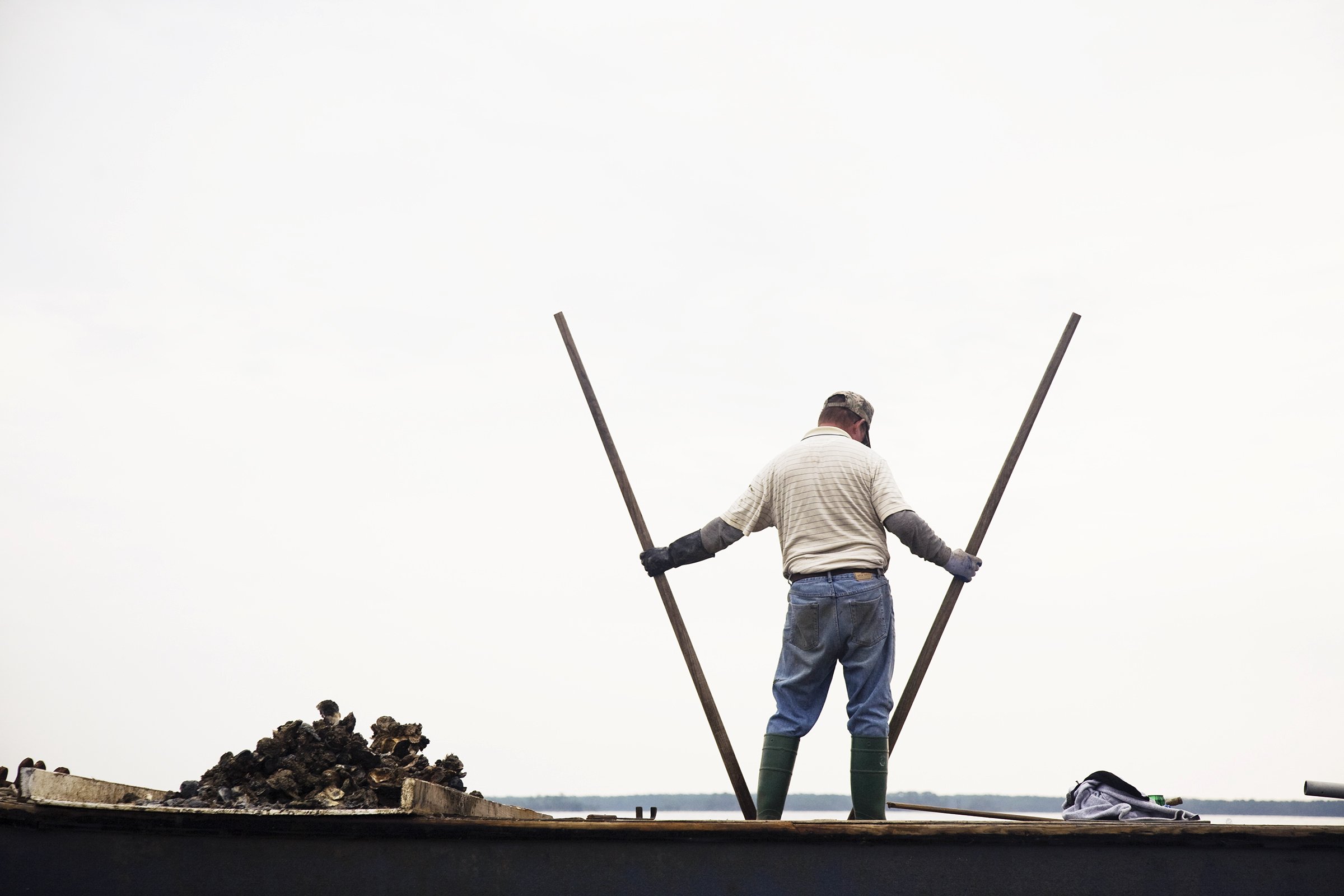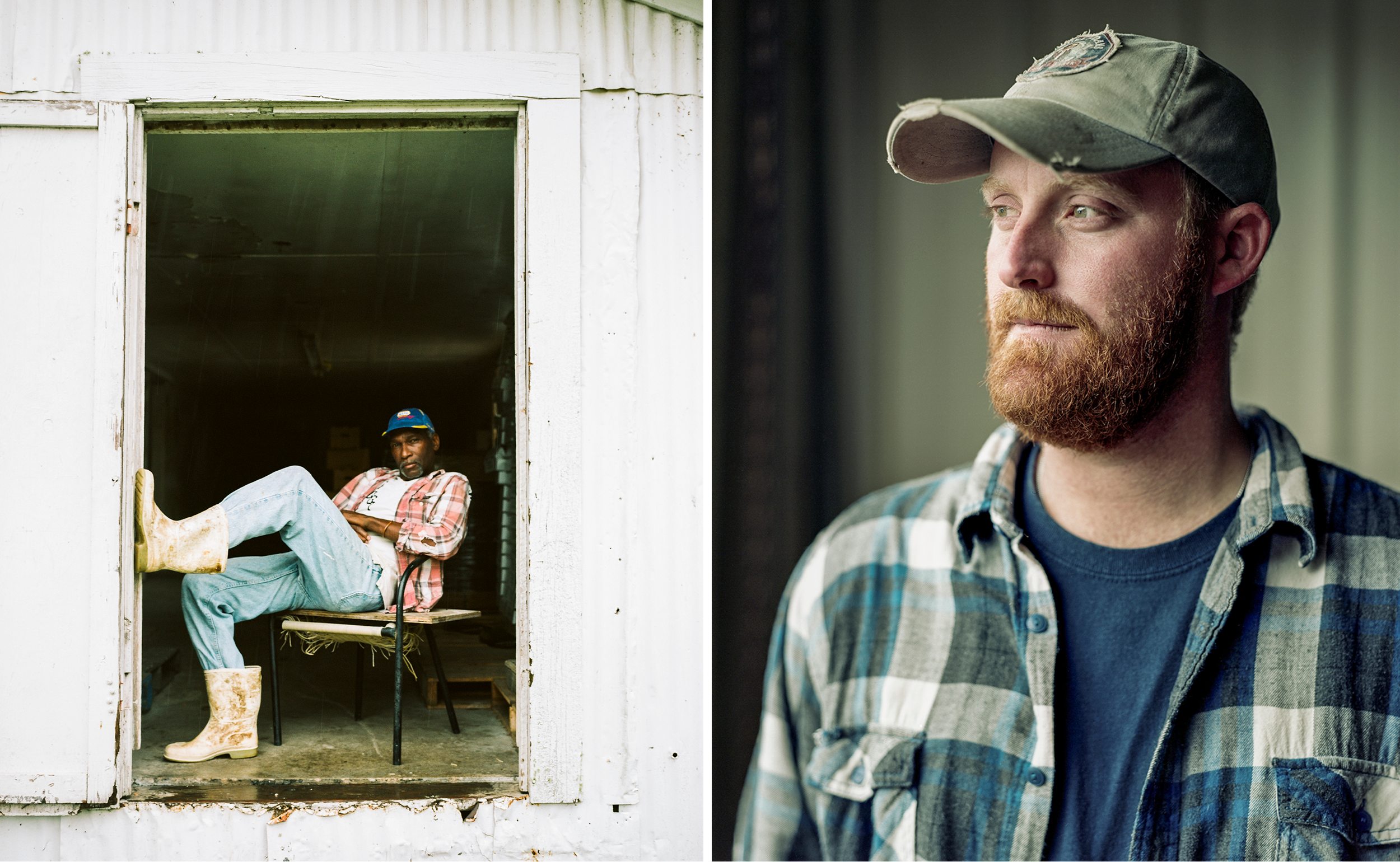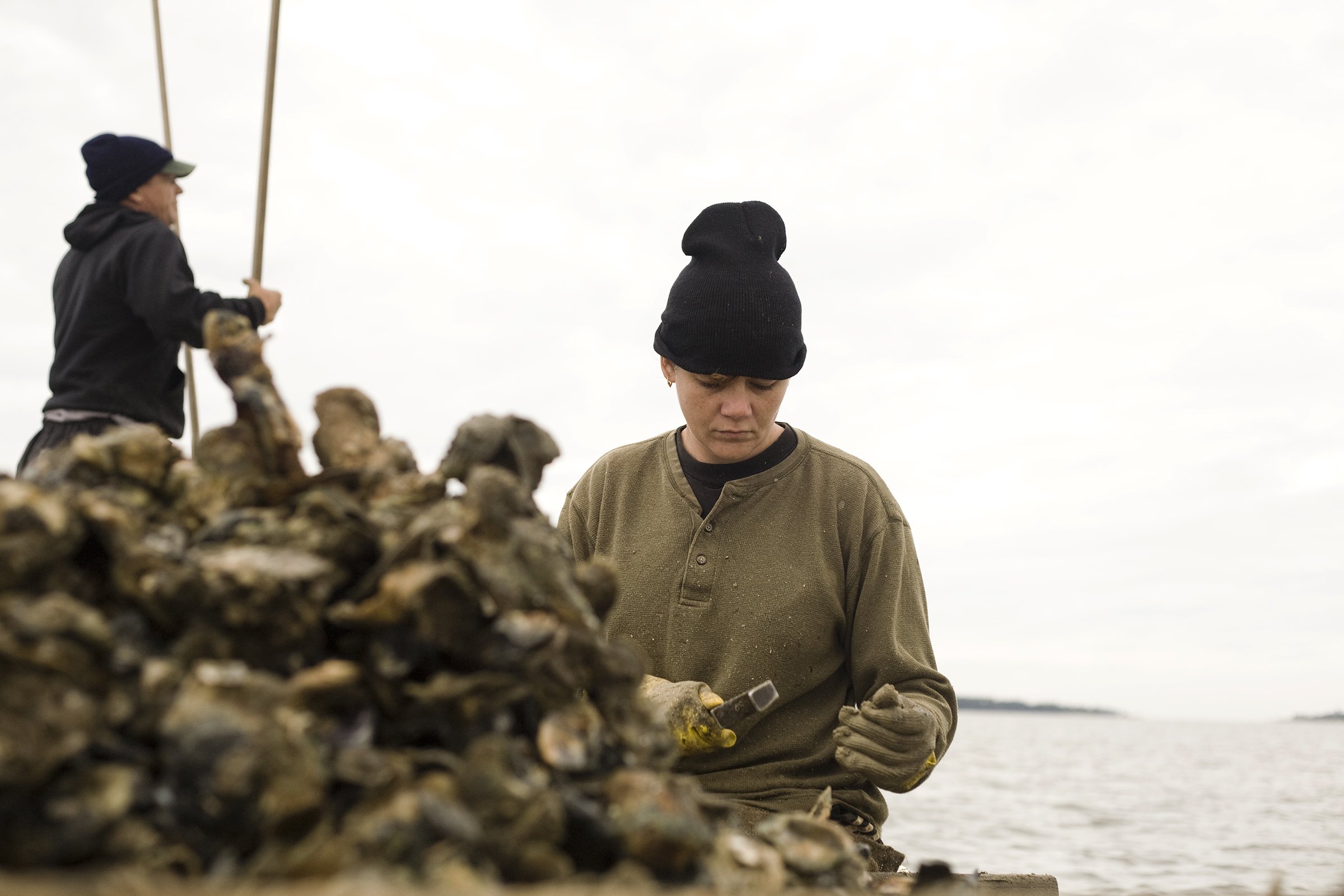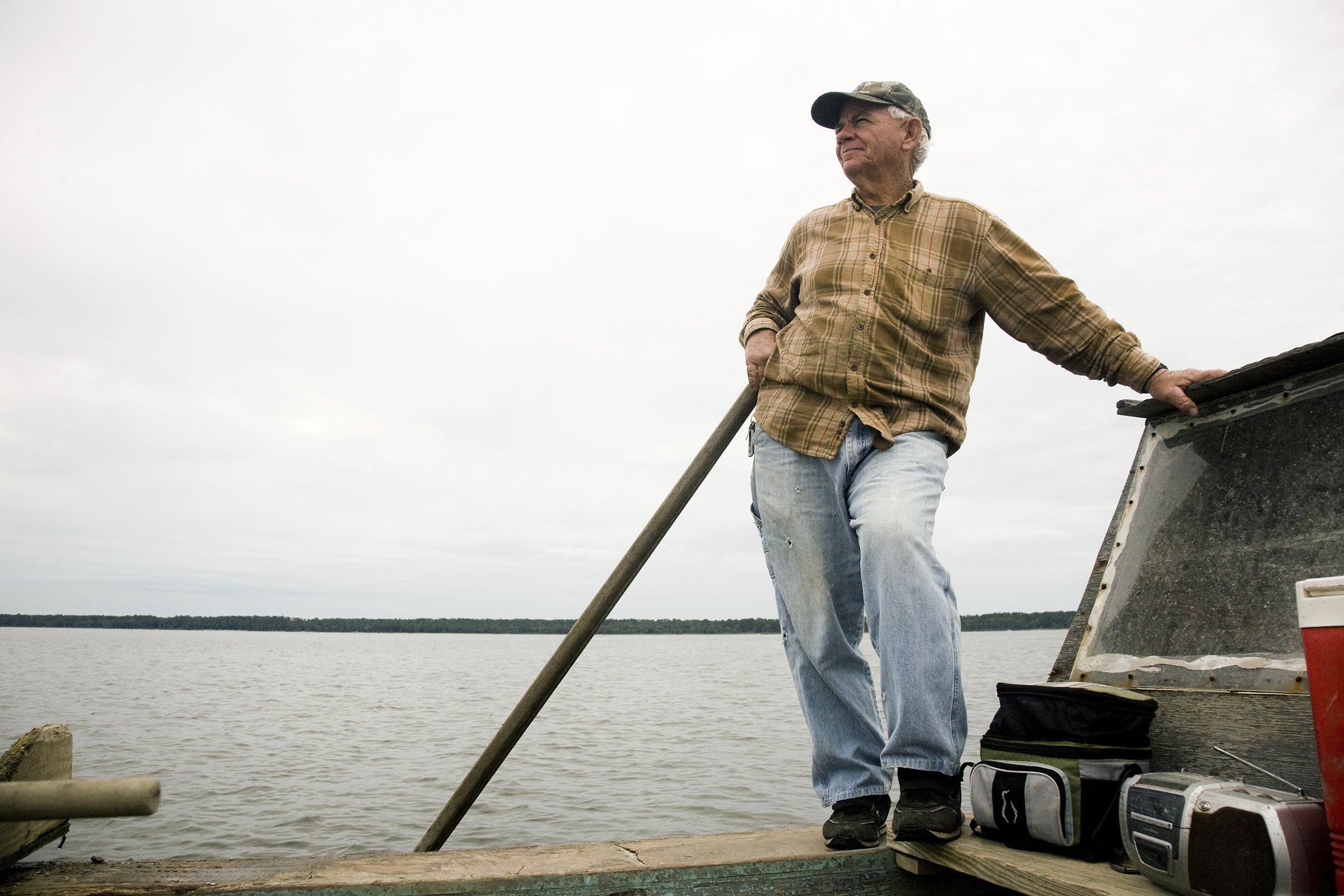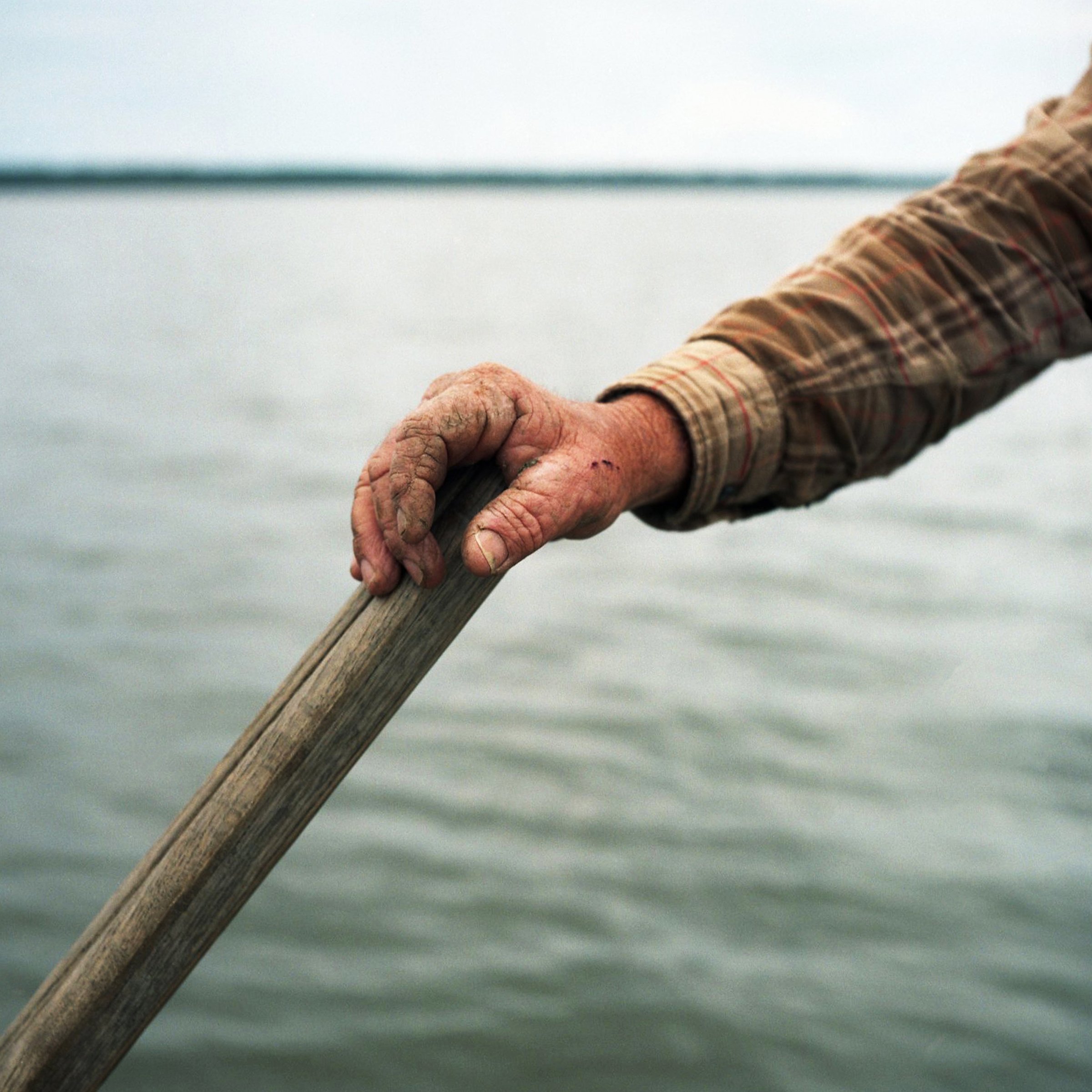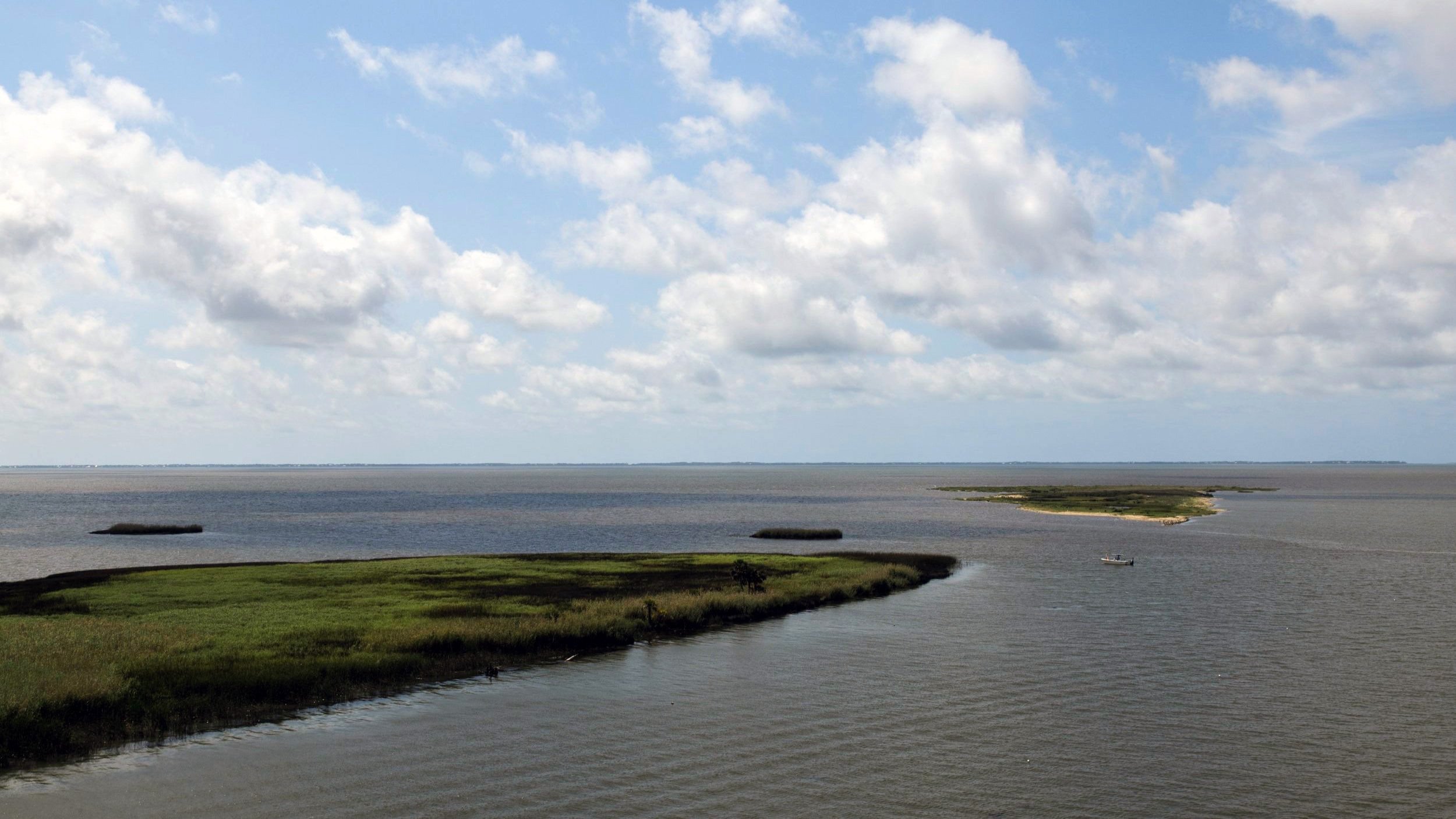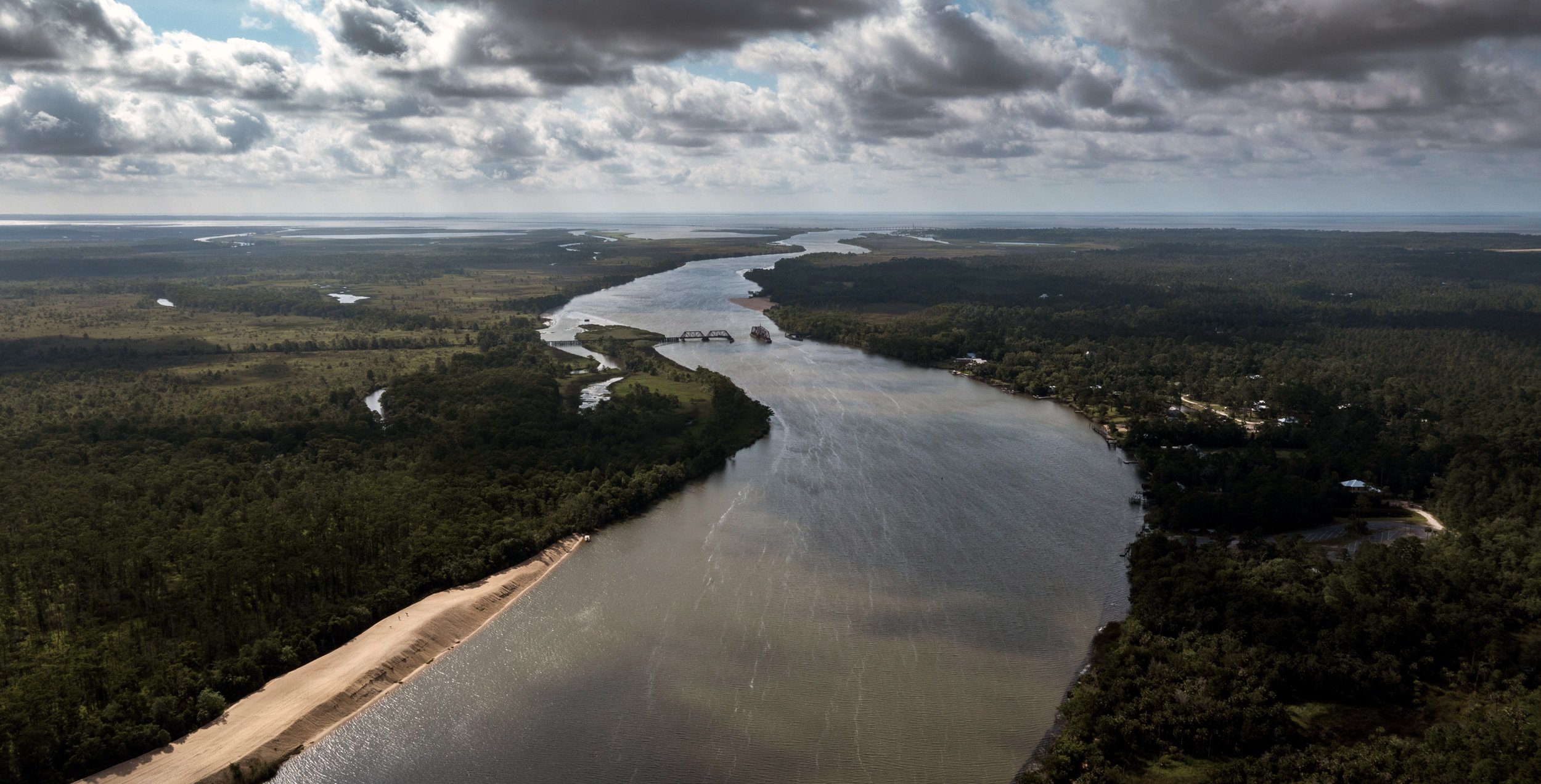As Florida’s oyster population declines, so goes the wisdom of people who have gathered oysters for generations.
Story by David Hanson | Photos & Video by Michael Hanson
At 60 years old, Kendall Schoelles, pronounced shell-ess, has never worked a land job. This morning, like most others, he drops his anchor, a rusted engine block, into 5 feet of latte-colored water, grabs a 10-foot-long rake handle made of pine, and steps to the edge of the boat. The rake’s handles cut a V against dawn’s cobalt sky. Then, as it drops in the water, the teeth clawing for shells make a muffled crunch.
Schoelles harvests oysters from beds his grandfather established in the early 1900s, 11 miles west of Apalachicola, Florida. He’s made his living aboard this 22-foot plywood skiff since 1984. Back then, over 400 similar skiffs would be spread across the bay — anchored at Cat Point, Indian Pass Lagoon, Dry Bar, Hagan’s Flats, 11 Mile, and Nick’s Hole.
Decades of accumulated oyster shells made up the beds (or reefs) sitting a few feet below the water’s surface. The oyster tongers would anchor over their favorite beds and literally rake up the oysters growing on top of the reef — with some rake loads yielding a dozen perfect oysters. A few local boat makers were building two to three skiffs per month in open-air backyard shops. Oyster shucking houses dotted the shore and the docks in downtown Apalachicola, neighboring Eastpoint, and down the bay to Tommy Ward’s 13 Mile Oyster House. Schoelles and his oyster tonger peers could clear $200-$300 a day.
This year, though, no one is taking oysters. In 2020, the state of Florida, responding to a historic collapse in oyster populations, closed Apalachicola Bay to all wild oyster harvesting for up to five years.
The 13 Mile Oyster House was destroyed by Hurricane Michael in 2018.
A severe drought that took place from 1955 to 1957, as well as hurricanes Elena and Kate (1985) and Dennis (2005), and tropical storms Fay (2008) and Debbie (2012), led to oyster declines, but the bay always recovered quickly. The state has historically regulated the harvests by closing the bay during some summer seasons and mandating a minimum size for the oysters that can be taken. But now is different.
Schoelles has a rare private lease on his 100-plus acres of beds. Although he’s allowed to rake, he won’t reap much of a harvest. He’s just here to see what he pulls up.
The rake’s rusted metal teeth emerge from the water and drop a mess of broken shells on the plywood culling board. They look like the scrapings from the bottom of a cereal bag.
“These are probably 50-, maybe 100-year-old oyster shells,” Schoelles says. “My granddad put them here. They should be buried under a mess of oysters.”
Schoelles puts the rake down and grabs a 60-pound sack of spent, sun-cured shells, the insides bleached white, smooth and clean as a dinner plate. He dumps them into the bay. It’s become an almost daily gesture of science, restoration, and hope.
Kendall Schoelles adds healthy, mature oysters to his beds in hopes of their producing spat for future harvest.
I first saw the oyster tongers in 2009, from a canoe. I’d paddled 500-plus miles on the Chattahoochee and Apalachicola rivers, starting in north Georgia and ending in the Gulf of Mexico at Apalachicola Bay.
In the bay, I paddled past low boats anchored in the west end. On one, a guy raked and culled alone, letters spelling “The Goat” affixed to the skiff’s cabin. A few hundred yards away, a man raked while a woman sat beside the broad culling board, tapping oyster clusters with a firm finesse, a pile growing beside her. She’d sweep the small ones and broken shells back into the bay with a mindless brush of her gloved hand. A painted cross and the words “Freedom” decorated the gray hull.
The oyster tonger cuts an independent, rugged shape atop the bay’s flat horizon. There’s no shelter from a frigid north wind, or from the summer thunderstorms that have killed people on the water. Oyster tongers work on their own schedule, with no boss, getting paid in cash based on their daily harvest. Big business never muscled its way into the scene. In Apalachicola, there’s no automated alternative to raking wild beds. The tongs are homemade from pine or fir by locals. Profits are based on market price and how hard you work. There’s a cowboy romance to the independent industry.
Apalachicola oyster tongers in 2009. In 2020, following a historic collapse in oyster populations, the state of Florida closed the bay to all wild oyster harvesting through 2025. Photos by Michael & David Hanson
I met Schoelles in 2013. I had again paddled down the entire watershed, this time with my brother. We were making a film about the Water Wars, the back-and-forth conflict between Alabama, Georgia, and Florida over allocation of fresh water. Historically, the Apalachicola — which is fed by the Chattahoochee and Flint rivers — deposits more water into the Gulf of Mexico than any river aside from the Mississippi. During the prolonged droughts of the late 2000s, Georgia relinquished only minimum flows to Florida. The lack of fresh water is widely recognized as the central culprit of the current oyster collapse.
The oysters themselves lead sedentary lives, attached to other oysters in clusters or reefs. Most spawning occurs in the summer, when the mature oyster releases eggs or sperm into the water column. The fertilized eggs then spend about two weeks floating as larvae, looking for a solid place to settle down, preferring other oyster shells. Once attached, they are officially baby oysters, known as spat, and they do not wander. When the spat develop into mature oysters, they can filter-feed nearly 2 gallons of water per hour, sifting bacteria, minerals, and nutrients brought down by the rivers.
“It takes the right mix of nutrients and salt and fresh water, but also the geography of the bay itself matters,” says Bill Walton, the Shellfish Aquaculture Program Coordinator at the Virginia Institute of Marine Sciences. “Part of the success of wild oysters is getting successful years with lots of fresh water to knock back predators and disease.”
There is a natural ebb and flow, Walton notes; in years when the rivers run low, populations temporarily decline. “But if you get a bunch of dry years, numbers really go down.” The oyster, once affixed to its reef, has to wait for life to come to it. In that way, the oyster is the ultimate downstream user, a keystone species stuck on the bottom, at the mercy of not only Mother Nature but our water power structure, too.
The Apalachicola is routinely dredged to allow boat traffic. One of the bay’s barrier islands has been artificially cut to open a new channel. Pumps on the Flint River irrigate cotton, corn, and peanuts. There are 14 dams in the upstream watershed. These rivers have been engineered to serve the demands of modern society. The bay gets whatever is left.
Looking downriver above the Apalachicola River toward Apalachicola Bay.
Despite all three states having governors in the same political party, the Republican leaders have never reached a compromise around water. The ACF Stakeholders — a tri-state coalition of industry leaders, municipalities, nuclear power plants, agriculture, scientists, and conservation groups — invested years of collaboration and more than $1 million in a hydrologic study, hoping to prescribe sufficient water to the Apalachicola, Chattahoochee, and Flint watersheds. Consensus was building. Then, in 2013, reacting to the oyster collapse in Apalachicola Bay, Florida Governor Rick Scott sued Georgia, claiming that Georgia overused Chattahoochee and Flint water, leaving an inadequate amount for the Apalachicola and downstream Florida users. The legal jockeying shelved the science and scrambled any budding compromise.
In a 9-0 decision, the U.S. Supreme Court ruled against Florida in 2021. Now that the legal fight is over, the ACF Stakeholders can revisit the possibility of implementing a new water-management regime, one that could ensure more fresh water for Apalachicola Bay.
A decade of natural challenges and legal and political conflict is a mere blip in the timeline of a species. The oysters will likely recover if fresh water returns. But what about the oyster tongers?
Perhaps because of its potentially deadly bacteria, raw oysters’ sea-to-plate stories were being touted by purveyors long before chalkboards listing food sources became restaurant-standard. The ice machine, first patented in 1851, meant oysters could be packed in barrels and shipped up the Apalachicola River, reaching East Coast cities. When a restaurant received a shipment of oysters, it would make ads promoting the amount on hand along with the oysters’ origin.
Otherwise unheralded fishing outposts like Bluffton and Daufuskie Island, South Carolina, and Apalachicola took on outsize culinary status as the sources of this exotic raw delicacy. St. George Island has beautiful beaches, but the oysters put Apalach on the map.
Apalachicola, a dot on Florida’s Forgotten Coast, still has the feel of an old, slightly gussied-up fishing village. There are appropriately authentic fishing boats tied up nearby, and it smells of salt and pluff mud. Buddy Ward & Sons Seafood and Trucking processing house and fish market remains prominent, rusty, and salty.
Oysters are shucked at Indian Pass Raw Bar in Port St. Joe, Florida.
The Forgotten Coast doesn’t seem as forgotten these days. It’s Memorial Day weekend — with many Americans emerging into a false sense of calm before the Delta variant surge — and Apalachicola is exploding. The last remaining hotel rooms cost over $400. The midafternoon crowd at Oyster City Brewing Company downtown spills off the sidewalk and into the street, where double-parked, lifted golf carts act as impromptu booths. It’s a 30-minute wait for a table at Tamara’s Café and Tapas Bar. Trays of dozen-raw-half-shell and cheese-crusted oysters cover the flat surfaces.
It hardly seems to matter that the bay is closed. People have come here for oysters, so oysters will be served, even if they are from Louisiana, Texas, and Florida bays farther east. Does anyone know the bay is, for all intents and purposes, dead? That without thick, stubborn oyster reefs anchoring the bay’s bottom, the town is more susceptible to powerful hurricane swells?
The iconic Boss Oyster, an oversize rambling wood shack on stilts leaning over the last hundred yards of the Apalachicola River, is closed, damaged in Hurricane Michael. It, along with the adjacent River Inn, Caroline’s River Dining, and the Roseate Spoonbill Lounge, was recently bought by a Florida investment firm. Time will tell what that restoration yields.
I order a beer and try to talk with the 50-something-year-olds in the golf carts about the bay closure. They glare at me then turn away, mumbling something about the media.
Tourists sit outside Hole in the Wall in downtown Apalachicola on a sunny afternoon. Tourism has become a major economic force for the onetime oyster capital of Florida.
Noah Lockley Jr.’s silhouette is barely visible behind the screen on his front porch. It’s midafternoon and hot; a porta-potty sits beside the road, rented by the neighbor for a high school graduation party. Lockley’s small clapboard house is in The Hill, Apalachicola’s historically Black neighborhood that begins a few blocks west of downtown and constitutes a “hill” only if viewed through a surveyor’s device or during a hurricane swell.
The Hill is Apalach’s hot real estate market. Home prices are quickly climbing as retirees, COVID work-from-home escapees, and Airbnb’ers buy up the Craftsman bungalows and clapboard homes.
Lockley grew up here, attending the all-Black Holy Family Catholic School until desegregation offered a chance to attend the town’s public school. He bought this house in 1975 at age 24, and he and his wife, Georgia Ann, raised their kids here. Lockley’s in his fourth term as the county’s District 3 commissioner, but an oyster skiff on a trailer beside the house, its purple paint faded and flaking, gives away his former vocation.
Noah Lockley Jr. spent his career raking oysters on the bay but doubts there will be many tongers left if the bay does come back. He’s currently serving his fourth term as the county’s District 3 commissioner.
He started on the water in 1972, after a stint in the Army. His father worked at the St. Joe Paper Company — but the mill employed only one family member at a time. So Lockley joined an uncle on the water. Eventually, he bought his own boat and took it to Louisiana and Mississippi to oyster in the summers when Apalachicola Bay would close.
“The bay was a good living,” Lockley says. “It was one of the main jobs in town. Everybody did it. Black and white, white and Black. You could take care of your family if you got out there and worked. My kids went out with me when they were in school. They’re mostly in law enforcement now.”
1985’s double whammy of hurricanes Elena and Kate was the worst year Lockley can remember. Tornadoes accompanied the hurricane winds and swells, destroying hundreds of acres of oyster beds. The oyster tongers stayed off the water for two seasons while the beds recovered. Then came what Lockley calls the bonanza years — plenty of oysters and money.
Things had changed radically by the 2010s. It wasn’t just the drought. Though oil from the 2010 BP Deepwater Horizon explosion never reached Apalachicola Bay, the fear of oil prompted the state to lift all restrictions on oyster harvests. It was as if during a food shortage, Kroger had opened its doors, removed the cash registers, and said, “Come and get whatever you can carry.” Tongers raked the bay to the mud.
“It’s so many things,” Lockley says. “If Mother Nature wants to come back, it’ll come back. But I don’t know who’s going to work the beds if they do come back. I won’t. There won’t be any more boats — they’ll all rot out. Most of the young guys who were oystering had to go back to get their GEDs and find land jobs. They thought the oystering would last forever. We all did.”
Retired oysterman David Gilbert at his home in Eastpoint, Florida.
Six miles away, across the Apalachicola River, is a no-stoplight town called Eastpoint. Schoelles had told me that a lot of oyster tongers live in this neighborhood; proof was in the skiffs languishing on trailers in many of the yards.
David Gilbert sits on his screened-in porch, an 8-foot-wide chest freezer behind him. He’s been here since 1949, back when there weren’t many other homes along Wilderness Road. When he was 14, he started oystering with his dad every Sunday. “My education is on the water,” he says.
Gilbert stopped oystering in 2014 and started looking for a land job. Since he’d never worked on land before, he feels lucky that he was hired by the state to manage roadside cleanup crews.
“Ninety percent of this neighborhood used to be oystermen,” he says. “It was scary when the oysters went down. I’m the breadwinner of the house. A lot of what you see around — rundown places and such — when you could oyster the bay, they had more respect for where they lived. I believe when the bay was working, it was like a machine — all the parts working together. Now it’s like a broken wheel. In five years, there aren’t going to be any more boats. They’ll all rot. No one will be making the tongs. Tourism doesn’t do nothing for the people around here.”
Gilbert looks out over his neat front yard to the three camellia trees he planted when he built his current house, next to the small sign that bears his family’s name. Across the street, short loblolly pines and scruffy, sun-baked shrubs extend to the horizon.
“I loved every minute of it. Actually, I sit out on this porch and think about it a whole lot. I miss it. In your story, you can call me a ‘retired, old, wore-out fisherman.’”
Schoelles can taste a local oyster and tell you what reef it came from. That’s one thing that happens when you spend a lifetime raking your granddad’s oyster lease. When his grandfather bought the lease in the early 1900s, there were thousands of acres of oyster beds in the bay. The state of Florida sold off some, like leasing land to farmers, for a small, renewable annual fee. The state cultivated the wild public beds that it managed, but the private leases were left to the leaseholder to maintain and harvest.
Schoelles’ dad never made a living oystering. He worked in the post office and, later, for the sheriff’s office — too lazy, as Schoelles puts it, for oystering. But his granddad passed along the lease, which has been reduced to just under 200 acres, to Schoelles, who has retained it for an annual fee. He lives alone in a small house under a broad canopy of oak trees, the maritime forest intent on overtaking his sheds, house, and truck as soon as he steps away.
Beatles posters, Florida State University football swag, family photos, and one Pearl Jam “Ten” poster adorn the living room walls. Schoelles was married for a while many years ago, but they never had kids. There’s one chair at the kitchen table. He brings out a few smooth stones angled into dull ax-like blades by the Native Americans who fished and ate oysters here for millennia. Schoelles’ family has been here for over a century.
He regularly drives into town to check on his 92-year-old mother and picks up bags of old shells. At home, he cures them in the sun.
Schoelles hopes to repopulate his bed for future harvest.
The Florida Fish and Wildlife Conservation Commission plans to “cultch” — deposit shells or other materials to create beds — but not until later this year. For now, state officials are testing materials and construction techniques to restore 1,000 acres of beds. (At one time the bay supported over 10,000 acres of productive wild oyster beds.) They are considering the potential of farming oysters in the bay. Florida State University, with $8 million from Triumph Gulf Coast (a nonprofit established to manage the funds from BP), is also studying the bay, with plans for restoration efforts.
Schoelles can’t wait. He pours Quikrete into egg cartons, then uses the concrete eggs to weigh down the baskets and offer a landing spot for passing oyster spat. He has 14 small baskets of live oysters and shells attached to buoys to keep them off the bottom. It’s his own version of oyster farming, a way back to productive wild beds: The baskets protect the young oysters from predation by crabs and conch while the spat can attach and develop safely.
“I don’t have the money for all the stuff you’d need to really farm them on top of the water,” Schoelles says. “Plus, nobody can find seed right now. And thieves would just grab the baskets anyway. But it’s something.”
In addition to cultching wild oyster beds, another proposed solution for the bay is aquaculture: farming oysters in big floating trays lifted off the ocean floor. But this replaces one challenge with another. Oystering on wild reefs may depend on the whims of nature — and the decisions of upstream humans — but it requires minimal equipment. Natural reefs are a shared public resource. Aquaculture hurtles the industry into privatization: If an oyster farmer invests in equipment and hard-to-find seed, they will want to control that part of the bay.
Virginia Institute of Marine Sciences’ Bill Walton has a stake in aquaculture. But, more so, he believes in the human culture that has developed around and helped cultivate wild fisheries. He and his wife had a small oyster farm in Cape Cod and, more recently, managed an oyster farm on Alabama’s Dauphin Island. “Shellfish aquaculture has helped a lot of communities, but there are equity issues. It takes money to set up aquaculture. There’s some concern that the entire Apalachicola Bay could be privatized, versus the open bay that they have now. I would hate [it] if aquaculture was ever used as a cudgel to say, ‘We’ve solved it if you just do it this way.’”
Nothing in nature exists in a vacuum, especially the bottom of a river. Peanut farms need their Flint River water. Millions of Atlantans need to drink and shower and shave, and the metropolis keeps growing. Alabama’s nuclear plants must be cooled with Chattahoochee water. None of that can be left to nature.
The South once had its own cowboys roaming the piney woods. They’re gone now; we have the beef, we just don’t need the cowboy. Perhaps the oyster tongers will go the same way.
Schoelles poling his way through shallow water to check on his oyster beds. He carefully monitors the health of the beds, checking weekly on the cages he's put out.
Schoelles holsters a pistol on his hip as we head out for a second morning. I hadn’t noticed it, tucked under his shirt, the day before. He started carrying the pistol every day after the Deepwater Horizon spill, when tensions were high on the bay. Today he’s just checking his baskets again, hoping to see new growth.
As oyster yields dwindled through the 2010s, fewer oyster tongers ventured onto the bay. Thirty dollars in gas money for $60 worth of oysters didn’t add up. Schoelles, adhering to his strict practice of harvesting only full-grown oysters, kept his beds going longer than most, but that just made them more appealing for theft.
Amid the Wild West mentality following Deepwater Horizon, Schoelles chased poachers off his lease in his boat. During that tense time, about a dozen poachers were arrested for stealing from his lease; four did jail time. In more recent years, with the oysters almost gone, he’s seen boats out, illegally, at night, poachers raking in a few dozen oysters here and there.
Schoelles wishes the state had closed the bay in the early 2010s as the numbers fell off a cliff. It crushed him when the state opened the bay up after the oil spill. He heard people were coming in with 50 to 60 bags of oysters at dawn, having been out all night. The contraband was bought by oyster houses to be packaged raw or shucked and shipped to restaurants. His friends in the oyster houses told Schoelles they knew the oysters were from his beds because no one grows them like he does.
“I checked my number 9 basket last week, and someone got my big oysters I put in there as cultch,” he tells me as we bob on the gentle bay just after dawn. “Probably some rich old bastard in a sport fishing boat just getting him a mess to eat for lunch.”
Before we motor back to shore, Schoelles checks his baskets, meticulously counting the predators: stone crab, blue crab, oyster drills (conch). He jots the tallies in his journal, along with daily notes on tides, weather, money earned.
Schoelles' journal, where he logs data on his oyster cultivation.
He’s kept the journals for years, initially as a way to keep track of his oyster harvests, income, and expenses. Since 2020, however, the journals’ columns of predators and prey have become a hand-written witness to what could happen if we leave the bay alone.
“People said the bottom’s dead and it ain’t never growing back,” he says. “I say bullshit. I want to show that the bottom ain’t dead.”
He fills each journal in a matter of months, then places it with the others on a shelf in his house. The obvious question is why. The writerly answer is almost too easy: An oyster bed’s future relies on its past. The discarded shells are a potential home for the next passing spat. If you rake clean the past, you imperil the future. The journaling notches the past, daily layers made up of predator and prey, of money made and money lost, tides in, tides out.
I ask Schoelles why he keeps the journals and what will become of them. “Just for the hell of it, really,” he says. “They’ll probably get thrown in the trash when I’m gone.”
Clarification, May 30, 2023:
This piece has been updated to reflect that skiffs were once anchored at Indian Pass Lagoon, not Indian River Lagoon as a previous version of the story stated.
David Hanson is a writer and filmmaker based in Oregon. His 2011 book Breaking Through Concrete chronicles the American urban farm movement, and his 2014 documentary film "Who Owns Water" tells the story of the water conflict between Georgia, Florida, and Alabama. He's currently working with the USDA to document the impacts of invasive feral swine on the American landscape.
Michael Hanson is an award-winning Pacific Northwest-based photographer/filmmaker. His photography career began while playing professional baseball in the Atlanta Braves organization. His in-depth storytelling work has taken him around the world for clients such as The New York Times, The New Yorker, The Washington Post, the Bill & Melinda Gates Foundation, Apple, and Starbucks. His fine-art work remains in the Sir Elton John Permanent Collection. He teaches as a Nat Geo Expert on NG Expeditions.










